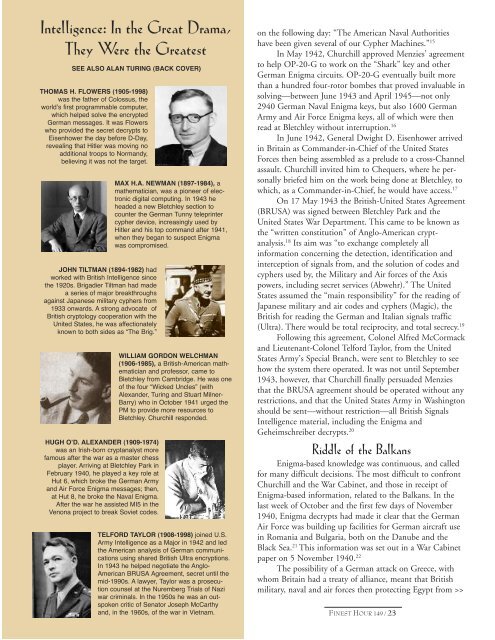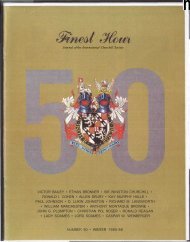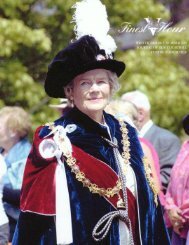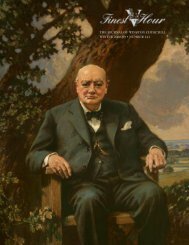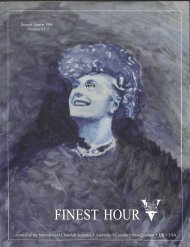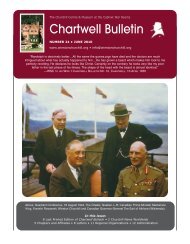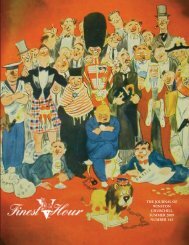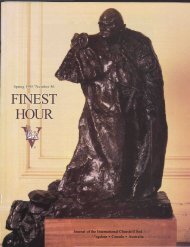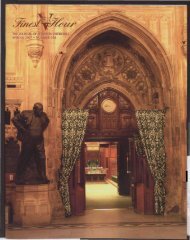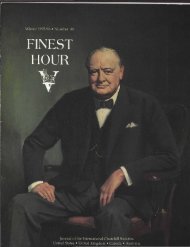GOLDEN EGGS...When he was in Britain, translated summaries of thedecrypts, and the Bletchley assessments, were sent him inlocked buff-coloured boxes to which he alone had the key.None of his Private Office knew what the contents were. Ashis Junior Private Secretary, John Colville, noted in his diaryat Chequers in May 1941: “The PM, tempted by thewarmth, sat in the garden working and glancing at me withsuspicion from time to time in the (unwarranted) belief thatI was trying to read the contents of his special buff boxes.” 7<strong>Churchill</strong> made his first visit to Bletchley on 6September 1941. His Principal Private Secretary, JohnMartin, who accompanied him in the car on their way toOxfordshire for the weekend, did not enter the building,and had no idea what went on there. 8Following his visit to Bletchley, <strong>Churchill</strong> received aletter, dated 21 October 1941, from four Bletchley cryptographers,Gordon Welchman, Stuart Milner-Barry, AlanTuring and Hugh O’D. Alexander. In their letter, theyurged <strong>Churchill</strong> to authorize greater funding for the workthey were doing. Manual decoding was extremely time-consuming.Turing believed that a machine he haddevised—the “bombe,” then in its early days—could speedup the task considerably, but that more funding and morestaff were needed. Milner-Barry later explained: “The cryptographerswere hanging on to a number of keys by theircoattails and if we had lost any or all of them there wasno guarantee (given the importance of continuity inbreaking) that we should ever have found ourselves in businessagain.” 9In view of the exceptional secrecy, Milner-Barry tookthe letter by hand to 10 Downing Street. He later reflected:“The thought of going straight from the bottom to the topwould have filled my later self with horror and incredulity.”On receipt of the letter, <strong>Churchill</strong> wrote to the head of hisDefence Office, General Ismay (his letter marked “ActionThis Day”): “Make sure they have all they want on extremepriority and report to me that this has been done.” 10“Almost from that day,” Milner-Barry recalled, “therough ways began to be made smooth. The flow of bombeswas speeded up, the staff bottlenecks relieved, and we wereable to devote ourselves uninterruptedly to the business inhand.” Brigadier Menzies—who rebuked GordonWelchman when they met for having “wasted fifteenminutes” of the Prime Minister’s time—reported to<strong>Churchill</strong> on November 18th that every possible measurewas being taken. Bletchley’s needs were met.<strong>Churchill</strong>, fully aware of the crucial role of BletchleyPark in averting defeat—and in due course, if all went wellon the battlefield, to secure victory—had ensured that fundswould be made available to improve the bombe, which wasdecisively to accelerate the decrypting of Enigma messages.In the second week of March 1943, Enigma decryptsof German dispositions in the Mediterranean disclosed thatfour merchant vessels and a tanker, whose cargoes weredescribed by Field Marshal Kesselring as “decisive for thefuture conduct of operations” in North Africa, would sailfor Tunisia on March 12th and 13th, in two convoys.Alerted by this decrypt, British air and naval forcessank the tanker and two of the merchant ships.Unfortunately, before despatching the interceptingforce, the British planners of the operation failed to providesufficient alternative sightings, so as to protect the Enigmasource. An Enigma decrypt on March 14th made it clearthat the suspicions of the German Air Force had beenaroused, and that a breach of security was being blamed forthe loss of the vital cargoes. <strong>Churchill</strong>, reading this decrypt,minuted at once that the Enigma should be withheld unlessit was “used only on great occasions or when thoroughlycamouflaged.” 11Fortunately for Britain, the Germans did not suspectthat their Enigma secret was the cause of this apparentbreach of their security. Nor did the Germans manage tobreak into Britain’s own Signals Intelligence system. Hadthey done so, they would have learned at once that Enigmahad been compromised.What to Tell the Americans?Following the visit to Britain of President Roosevelt’semissary Harry Hopkins, in January 1941, <strong>Churchill</strong> agreedthat the United States could share information concerningEnigma, and could do so without delay. In February 1941the Currier-Sinkov mission from the United States broughta Japanese Foreign Office “Purple” cypher machine andother codebreaking items to Bletchley, where ColonelTiltman’s solutions of Japanese army code systems, whichhe explained to the American cryptographers during theirvisit, represented the first solutions of Japanese army materialthat United States cryptanalysts had seen. 12In his own reading of Enigma, <strong>Churchill</strong> was alwayson the lookout for items that he felt should be sent toRoosevelt. Especially with Enigma decrypts and interpretationsthat related to the Far East and the Pacific, he wouldnote for Brigadier Menzies: “Make sure the President knowsthis” or “make sure the President sees this.” 13In April 1942, four months after the Japanese attackon Pearl Harbor, <strong>Churchill</strong> authorized the visit by ColonelTiltman to OP-20-G, the United States Navy’s cryptanalyticoffice in Washington DC. 14 During Tiltman’s visit itbecame clear that the United States Navy wanted to attackthe German naval “Shark” key, against which Bletchley hadmade almost no progress since the introduction of the fourrotorEnigma (M4) on 1 February 1942: this Shark keyprovided the German Navy with all top-secret communicationswith its submarines.On 8 February 1942, <strong>Churchill</strong> wrote to Menzies:“Do the Americans know anything about our machine? Letme know by tomorrow afternoon.” Colonel Menzies repliedFINEST HOUR 149 / 22
Intelligence: In the Great Drama,They Were the GreatestSEE ALSO ALAN TURING (BACK COVER)THOMAS H. FLOWERS (1905-1998)was the father of Colossus, theworld’s first programmable computer,which helped solve the encryptedGerman messages. It was Flowerswho provided the secret decrypts toEisenhower the day before D-Day,revealing that Hitler was moving noadditional troops to Normandy,believing it was not the target.JOHN TILTMAN (1894-1982) hadworked with British Intelligence sincethe 1920s. Brigadier Tiltman had madea series of major breakthroughsagainst Japanese military cyphers from1933 onwards. A strong advocate ofBritish cryptology cooperation with theUnited States, he was affectionatelyknown to both sides as “The Brig.”HUGH O’D. ALEXANDER (1909-1974)was an Irish-born cryptanalyst morefamous after the war as a master chessplayer. Arriving at Bletchley Park inFebruary 1940, he played a key role atHut 6, which broke the German Armyand Air Force Enigma messages; then,at Hut 8, he broke the Naval Enigma.After the war he assisted MI5 in theVenona project to break Soviet codes.MAX H.A. NEWMAN (1897-1984), amathematician, was a pioneer of electronicdigital computing. In 1943 heheaded a new Bletchley section tocounter the German Tunny teleprintercypher device, increasingly used byHitler and his top command after 1941,when they began to suspect Enigmawas compromised.WILLIAM GORDON WELCHMAN(1906-1985), a British-American mathematicianand professor, came toBletchley from Cambridge. He was oneof the four “Wicked Uncles” (withAlexander, Turing and Stuart Milner-Barry) who in October 1941 urged thePM to provide more resources toBletchley. <strong>Churchill</strong> responded.TELFORD TAYLOR (1908-1998) joined U.S.Army Intelligence as a Major in 1942 and ledthe American analysis of German communicationsusing shared British Ultra encryptions.In 1943 he helped negotiate the Anglo-American BRUSA Agreement, secret until themid-1990s. A lawyer, Taylor was a prosecutioncounsel at the Nuremberg Trials of Naziwar criminals. In the 1950s he was an outspokencritic of Senator Joseph McCarthyand, in the 1960s, of the war in Vietnam.on the following day: “The American Naval Authoritieshave been given several of our Cypher Machines.” 15In May 1942, <strong>Churchill</strong> approved Menzies’ agreementto help OP-20-G to work on the “Shark” key and otherGerman Enigma circuits. OP-20-G eventually built morethan a hundred four-rotor bombes that proved invaluable insolving—between June 1943 and April 1945—not only2940 German Naval Enigma keys, but also 1600 GermanArmy and Air Force Enigma keys, all of which were thenread at Bletchley without interruption. 16In June 1942, General Dwight D. Eisenhower arrivedin Britain as Commander-in-Chief of the United StatesForces then being assembled as a prelude to a cross-Channelassault. <strong>Churchill</strong> invited him to Chequers, where he personallybriefed him on the work being done at Bletchley, towhich, as a Commander-in-Chief, he would have access. 17On 17 May 1943 the British-United States Agreement(BRUSA) was signed between Bletchley Park and theUnited States War Department. This came to be known asthe “written constitution” of Anglo-American cryptanalysis.18 Its aim was “to exchange completely allinformation concerning the detection, identification andinterception of signals from, and the solution of codes andcyphers used by, the Military and Air forces of the Axispowers, including secret services (Abwehr).” The UnitedStates assumed the “main responsibility” for the reading ofJapanese military and air codes and cyphers (Magic), theBritish for reading the German and Italian signals traffic(Ultra). There would be total reciprocity, and total secrecy. 19Following this agreement, Colonel Alfred McCormackand Lieutenant-Colonel Telford Taylor, from the UnitedStates Army’s Special Branch, were sent to Bletchley to seehow the system there operated. It was not until September1943, however, that <strong>Churchill</strong> finally persuaded Menziesthat the BRUSA agreement should be operated without anyrestrictions, and that the United States Army in Washingtonshould be sent—without restriction—all British SignalsIntelligence material, including the Enigma andGeheimschreiber decrypts. 20Riddle of the BalkansEnigma-based knowledge was continuous, and calledfor many difficult decisions. The most difficult to confront<strong>Churchill</strong> and the War Cabinet, and those in receipt ofEnigma-based information, related to the Balkans. In thelast week of October and the first few days of November1940, Enigma decrypts had made it clear that the GermanAir Force was building up facilities for German aircraft usein Romania and Bulgaria, both on the Danube and theBlack Sea. 21 This information was set out in a War Cabinetpaper on 5 November 1940. 22The possibility of a German attack on Greece, withwhom Britain had a treaty of alliance, meant that Britishmilitary, naval and air forces then protecting Egypt from >>FINEST HOUR 149 / 23


